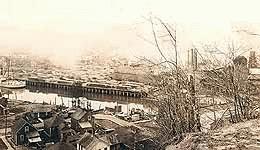On June 1, 1895, Aberdeen businessmen connect their own railroad to the Northern Pacific. In 1892 the Northern Pacific Railroad selected Ocosta as its terminus on Grays Harbor. Local Aberdeen businessmen take matters into their own hands and begin building their own spur with donated land and materials to connect to the transcontinental line.
The residents of Aberdeen were disappointed but not dismayed when the Northern Pacific announced it would run rails to Ocosta. This resulted in a land boom there and the line had been surveyed when the Panic of 1893 suspended all construction. Railroad officials approached Aberdeen leaders with an offer to build a line to Aberdeen if the city would subsidize the estimated cost of $35,000. Aberdeen rejected this offer as too expensive, but several local business leaders, including John Weatherwax, A. J. West and Henry Wilson, settled upon the idea of building their own, less expensive, spur.
Back in June 1888, a British ship named the Abercorn had run aground at the entrance to Grays Harbor. Among the Abercorn's cargo were 5,000 lengths of railroad rails. The Aberdeen businessmen picked up these rails at a delinquent tax sale and donated them to the building project. Mill owners donated railroad ties and Aberdeen's founder, Samuel Benn, offered building lots to individuals who would donate their time and labor to the project. He also provided land for the depot and a freight yard. Support for this community project was widespread and the new Aberdeen line was completed and turned over to the Northern Pacific on June 1, 1895.
Completion of this connection to the Northern Pacific helped to solidify Aberdeen's growing dominance over the other Grays Harbor communities. The new railroad connection did not supplant the key role of the coastal schooners, but it provided a much needed link to the east, making the region less isolated from the rest of the state.

